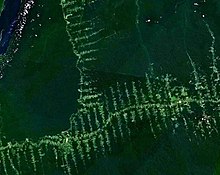User:Brealey6/sandbox
Human Dimension Of Deforestation and Climate Change
[edit]Deforestation is often described as the changing of land from forested to non-forested by means both natural and unnatural. The relationship between deforestation and climate change is one of a positive feedback loop. The more trees that are removed equals larger effects of climate change which, in turn, results in the loss of more trees. In recent history, this process has been accelerated and amplified by humans in many different ways. These include logging, urbanization, mining, and agricultural development. The incessant need to expand these operations has resulted in widespread deforestation worldwide.

Agricultural
[edit]Agricultural expansion is one of the worst offenders in when it comes to deforestation in recent times. Since 1960, roughly 15% of the amazon has been removed with the intention of replacing the land with agricultural practices [1] . In Brazil specifically, the jungle has been wiped out in order to house cattle and other valuable agricultural items by means of ‘fishbone deforestation’ [2]. Fishbone is in reference to the visual aesthetic of the scarred land and how it branches off from the roadside in straight lines. This style of deforestation has proven to be fast moving and efficient while tearing apart the land that humans, plants, and animals all inhabit. It is no coincidence that Brazil has recently become the world’s largest beef exporter at the same time that the Amazon rain forest is being clear cut[3].
Illness
[edit]The acceleration of deforestation affects humans in many other categories. It is displacing native tribes; it is eliminating one of the largest oxygen providers and carbon sinks in the world; and it can even lead to sickness and disease. Deforestation sends a shock wave through the natural world, resulting in many previously unforeseen complications. This just goes to show just how much of an impact humans can have on themselves by continuing to take down forested land. One example regarding the possibility of human sickness can stem from some of the wildlife that is being displaced and killed off, birds to be more specific. Birds are being forced to live in new habitats due to many species being relocated. These newer areas area already home to many other species, this combination of species can sometimes result in inter-species illness and can be transmitted to humans [4][5]. This is just one example of the large butterfly effect that human caused deforestation can have on humans.
Urbanization
[edit]The cases of urbanization and agriculture are closely related when it comes to deforestation and climate change. As more large agriculture companies are taking over the arable lands, more families are moving to large cities in order to find work. More people means that more space is needed, and there are two ways to accommodate it, going up or going out. Both require resources and going out requires land, so more deforestation is a very real possibility in this situation. More people in the cities means that more power is needed to keep every ting running, and more water needs to be pumped in to meet the growing needs. All of this requires more energy, which releases more pollution, furthering the damage that has been caused[6] [7]. We can look in either direction and continue this timeline of damage being caused by the need to expand and accommodate human needs and desires, as most choices will have impacts elsewhere.
The human dimension of deforestation and climate change is that of an intentionally created feedback loop that only amplifies the destruction of the planet and to a large degree the species as a whole. A desire to expand into forest covered lands has resulted in scarred land, displaced species (including humans), larger cities, more emissions, and even illness.
 | This is a user sandbox of Brealey6. You can use it for testing or practicing edits. This is not the sandbox where you should draft your assigned article for a dashboard.wikiedu.org course. To find the right sandbox for your assignment, visit your Dashboard course page and follow the Sandbox Draft link for your assigned article in the My Articles section. |
- ^ "Cattle ranching in the Amazon rainforest". www.fao.org. Retrieved 2020-02-25.
- ^ Geist, Helmut (2001). "What Drives Tropical Deforestation?" (PDF). LUCC Report. 4.
{{cite journal}}: line feed character in|title=at position 12 (help) - ^ "Growth of Brazil's Beef Industry Fueling Fires Destroying Amazon Rainforest". KTLA. 2019-08-23. Retrieved 2020-02-25.
- ^ Sehgal, R. N. M. (2010-03-15). "Deforestation and avian infectious diseases". Journal of Experimental Biology. 213 (6): 955–960. doi:10.1242/jeb.037663. ISSN 0022-0949. PMC 2829318. PMID 20190120.
{{cite journal}}: CS1 maint: PMC format (link) - ^ Voldoire, A.; Royer, J. F. (2004-07). "Tropical deforestation and climate variability". Climate Dynamics. 22 (8): 857–874. doi:10.1007/s00382-004-0423-z. ISSN 0930-7575.
{{cite journal}}: Check date values in:|date=(help) - ^ Richards, Peter; VanWey, Leah (2015-07-04). "Where Deforestation Leads to Urbanization: How Resource Extraction Is Leading to Urban Growth in the Brazilian Amazon". Annals of the Association of American Geographers. 105 (4): 806–823. doi:10.1080/00045608.2015.1052337. ISSN 0004-5608. PMID 26985079.
- ^ Browder, John (2003). "The urban-rural interface: Urbanization
and tropical forest cover change". Urban Ecosystems. 6: 21–41 – via Kluwer Academic Publishers.
{{cite journal}}: line feed character in|title=at position 40 (help)
